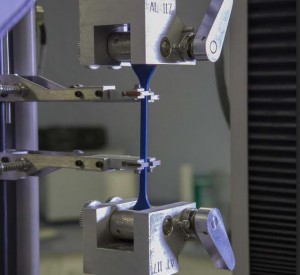In order to provide guidance in the selection of rubber materials, the Society of Automotive Engineers (SAE) and the American Society for Testing and Materials (ASTM) established ASTM D2000. By using a designation method called the “line call-out,” engineers have a readily available classification system for elastomer compounds.
Below is a complete breakdown to better understand the system.
ASTM D2000 by Industry
Many times, customers will ask engineers which specification should be used for a specific rubber compound. ASTM D2000 gives an ideal way to designate a rubber polymer and assign realistic and physical properties that customers need for an application.
SAE titles ASTM D2000 as the “Standard Classification System for Rubber Products in Automotive Applications.” The title should, however, be the “Standard Classification for Rubber Products for All Industries” — since automotive, aerospace, medical and industrial all benefit from this standard.
Why it’s necessary:
Military applications: When designs add Aerospace Material Specifications (AMS), they will often be standards with outdated physical requirements or dynamic properties that are no longer tested — adding delays to lead times or adding substantially to final piece price.
Medical applications: There are no defined standards for medical applications yet. ASTM D2000 provides an easy way to assign standard physical properties to show what you are buying and what testing is performed.
Specifying elastomers via standardized line call-outs is strategic because it allows the flexibility of using different manufacturers’ compounds — while ensuring that material quality and performance remain consistent.
Below is a standard line call-out for a Nitrile rubber compound. Each designation is defined with given tolerance levels, based on the grade.
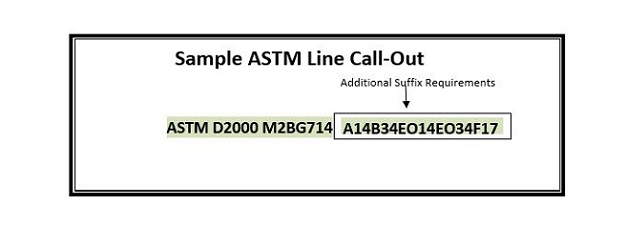
The above call-out contains the following:
ASTM D2000: Document name.
M: The letter “M” may or may not be present – this represents the unit of measure, which is stated in SI (metric) units. If the “M” was not present, English units would be used.
2: Grade number. The grade number defines specific added test requirements, which are desirable in cases where the basic requirements may not ensure an acceptable material.
BG: Type and Class. The Type is based on changes in tensile strength. A reference chart is always given to show which polymers are used with a corresponding Type and Class.
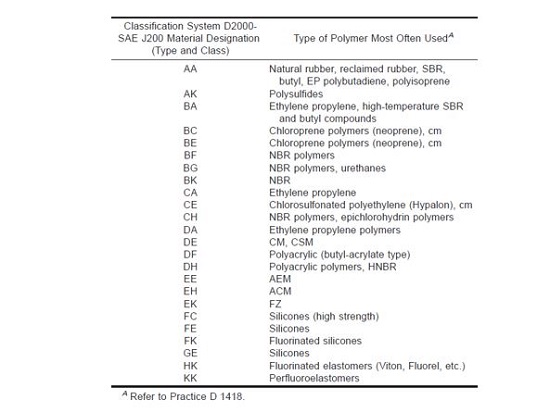
Type is based on change in tensile strength after heat aging for 70 hours at a given temperature, stated below:
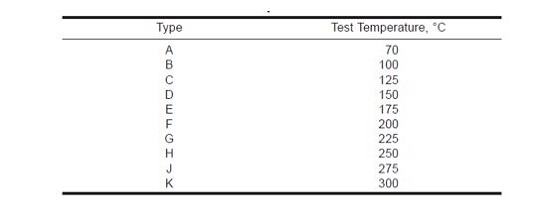
Class is based on the resistance of the material to ASTM Oil IRM903 after a 70-hour immersion. Below shows volume swell by class:
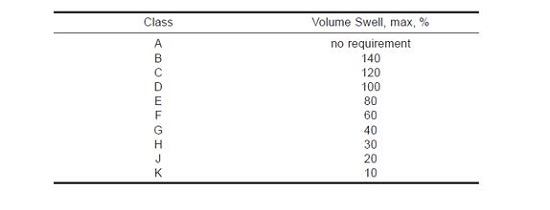
7: The next digit, 7, specifies the hardness of the material – in this case, Shore A durometer. For standard physical properties, hardness is taken at ± 5.
14: This digit indicates the tensile strength – for example, 14 for 14MPa. These values are typically based on what standard polymers are actually used in the industry. Remember, this will be in SI units if the letter “M” is present in the call-out. To convert to psi, simply multiply the MPa number by 145.
Additional suffix requirements: A14B34EO14EO34F17
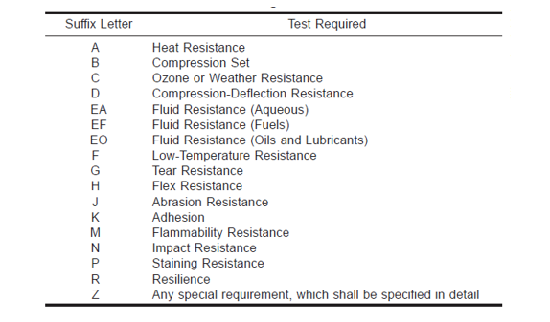
A14B34EO14EO34F17 is the second half of the original sample ASTM line call-out.
Inserting additional call-outs, as shown above, should be used depending on your applications. If the rubber part will see high temperature exposure, it is wise to add a heat resistance requirement (A). This will add a tighter tolerance on physical property change after a heat age exposure. Many sealing applications are compression set-dependent, so using a compression set resistance call should give a more robust compound.
Call-outs for Ozone, Fluid Aging, Low temperature, Tear, Adhesion and Staining can be used, but should be based on what the application will actually see.
Special Requirements for ASTM D2000
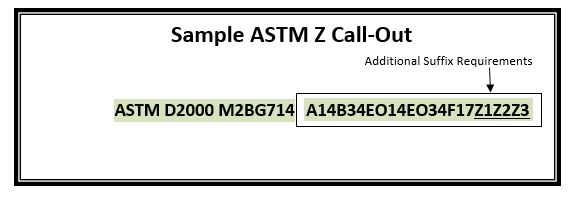
Special requirements can be added using a “Z” call-out. This is typically done after the last call-out and number. Below are a few examples that we have seen over time:
Z1 – A14 Use Grade 4 requirements
(Since grade 2 does not have A14 call outs, this designates which to use)
Z2 – Color Blue
(Specific Color is required for a project)
Z3 – FDA 21 CFR 177.2600 complaint
(Regulatory requirements need to be met)
The various call-outs can be used to meet specific needs of an application. They can be used to specifically assure a given polymer time like, Z1- polymer EPDM, or to assure a specific grade–like Z1 – Medical Silicone.
ASTM Tips to remember:
1) Using basic call-outs can give more robust compounds.
Even without additional call-outs, using the ASTM D2000 will give basic requirements. Typically, it is a minimum physical requirement for a heat age, oil age (depending on polymer), and a compression set test. Solely using these minimum call-outs can help put controls in place to assure quality compounds are used — leading to a more robust part. An example would be ASTM D2000 M2BG710.
2) Testing call-outs should be based on actual applications.
Adding an “alphabet soup” as it is called, can add significant cost to the compound. Molders may have standard compounds to meet most basic ASTM call-outs. If a design adds all call-outs on a given type, it would require special testing and modification to the compound. This can result in additional cost and delayed deliveries.
For being one of the most versatile and complex specifications in the rubber industry, understanding the ASTM D2000 call-out system can actually be pretty simple. In addition to helping you specify compounds, familiarity with this system will also help in making sense of material test reports.
